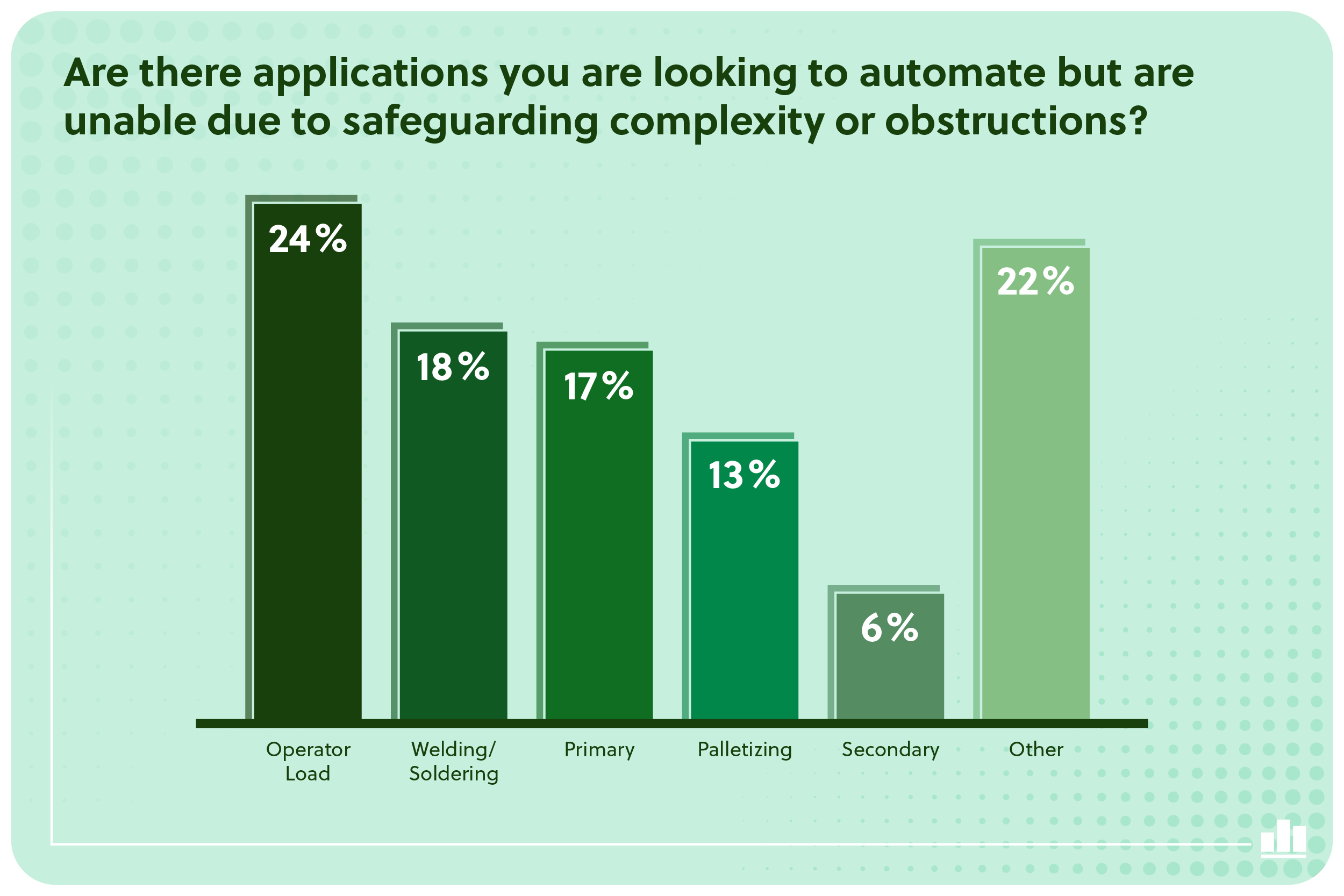Veo Robotics’ 2022 Manufacturing Automation Outlook
Overview
The use of robotics and automation within the manufacturing industry has experienced significant growth over the last few years. North American industrial robot sales had their strongest year ever in 2021, according to A3, and global robot purchases are expected to increase to $31B by 2028.
In the shadow of a waning pandemic and in the face of persistent supply chain issues, unprecedented labor shortages, and inflation, manufacturers continue to recognize the urgency to automate their operations. The need for new technological solutions to these manufacturing and logistics headwinds has led investors to allocate billions of dollars to fund robotics and automation innovations.
With this as a backdrop, Veo Robotics, the industrial automation company and developer of FreeMove, the 3D safeguarding system for industrial robots, recently surveyed more than 500 manufacturers across the US, UK, and Japan to inform the following Veo Robotics’ 2022 Manufacturing Automation Outlook. The outlook explores the ways manufacturers are integrating robots into their workforce, how this integration impacts their facilities and human workers, and what organizations can do to optimize their robotics strategy to pave a path toward success.
The New ‘Hybrid’ Human-Robot Workforce
Over 55% of those surveyed by Veo report having ten or more robots in their facilities, with nearly 1-3 of manufacturers (32%) saying they have 30 or more. While these numbers might not rival the army of robots that companies like Amazon have at their disposal — around 350,000 across their facilities — when you consider the expense and space requirements for industrial robots today, it’s clear that manufacturers of all sizes are making sizable investments in these hi-tech workers.
Given that robots are now automating many of the tasks that human workers used to perform, is this proof that robots are rendering humans obsolete? While it’s true that the World Economic Forum estimated in October 2020 that, by 2025, robotics would displace around 85 million jobs, they also reported that it would also create 97 million new jobs.
Our findings reinforce that the myth of robots stealing humans’ jobs is just that. 57% of manufacturing professionals say that robots are not replacing human workers in their facilities but rather working alongside humans to supplement their work. A further 22% said robots are being put to work within their own siloed sections of factories. Only a fifth (21%) of respondents believe robots are replacing human workers in their workforce.
In many ways, robots aren’t taking away the roles of humans, they're making them more valuable. By automating the more mundane and repetitive tasks and the risks involved with them, automation is freeing up humans to do more challenging work, including interfacing with customers, developing better products, and even managing robots themselves.
With all of this in mind, it’s not surprising that 61% of manufacturers say that human-and-robot interaction has at least somewhat increased over the last year. As manufacturers accelerate their adoption of automation and continue to fill warehouses with robots, it only makes sense that human and machine co-workers are interacting more around the office.
Striking the Balance Between Safety & Efficiency
Robots are inherently dangerous, but because of manufacturers' commitment to safety, industrial accidents involving robots are rare. In fact, if you do the math, with roughly 250 million vehicles in operation in the US, you’re about 150 times more likely to be killed by a car than by a robot. However, as the use of robots skyrockets, what does need safeguarding is the interaction between humans and their robot peers.
Despite headline grabbing attention when accidents do occur, the reality is that the number of robot-related injuries has fallen drastically during the past couple decades, with just 20 since 2004 according to OSHA. That data supports why 63% of manufacturers surveyed noted they are at least ‘moderately satisfied’ with their safety when interacting with robots. However, the legacy robot safety that many of these manufacturers rely on, while often effective, is focused on keeping robots completely siloed from their human coworkers.
In fact, according to our findings, fully fenced caged environments (41%) are still the most used safeguards in manufacturing facilities today. This approach was used significantly more than less restrictive safeguarding measures. 17% of manufacturers said they use light curtains, and 14% noted they rely on area scanners as safeguarding measures. Meanwhile, pressure sensing mats, power and force limiting (PFL) robots, and “other” safeguarding methods garnered 9% of responses each.
So while most manufacturers are keeping their workers safe through caged environments, they are becoming incredibly inefficient from a modern manufacturing standpoint when it comes to other areas such as speed, efficiency, and flexibility. The result can mean curbing a lot of the benefits that manufacturers were seeking to gain by increasing their use of automation and robots in the first place.
With 44% of manufacturers noting that they enter workcells at least every 1-2 hours, it’s not surprising that an additional 63% report that their workcell safeguarding solutions pose challenges in the form of limiting flexibility, increasing human workloads, constraining space, and slowing down production time.
Calling into question the efficiency of these safety measures even further, 81% of manufacturers said they deal with robot-led production shutdowns. Some even on an exceedingly frequent basis. More than a fifth of respondents said that nuisance faults with their current robot workcell safeguarding methods cause production to shut down at least every couple of hours. An additional 21% said this occurs “a couple of times a day.”
An increase in faults coupled with more tasks for human workers slows down production time, which of course, increases expenses. These increasing costs are something that nearly all global manufacturers are struggling to deal with alongside supply chain constraints. In fact, manufacturers noted that “reducing the cost and complexity of manufacturing” was one of their biggest challenges over the next six months to a year. The 33% describing these production cost problems were just behind those that noted supply chain constraints (34%) and that hiring and training skilled workers (37%) were some of their biggest challenges.
Freeing Manufacturing Facilities from Automation Constraints
Industry data highlighting manufacturers’ automation increases since the beginning of the pandemic is undoubtedly a positive sign of the industry embracing innovation. However, as the machine workforce evolves, so must the environments they are working within.
To optimize their investments, manufacturers must create an environment conducive to this new hybrid workplace. To do this, manufacturers must create environments where robots and humans can work nearby as collaborators to optimize space and increase productivity. Ironically, however, as manufacturers are increasingly seeking ways to automate their processes, antiquated safeguarding measures are, in many cases, hindering their ability to embrace it fully.
In fact, manufacturers surveyed by Veo cited many areas that they would like to automate but cannot because of safeguarding complexities or obstructions. Areas mentioned include, operator load stations (24%) welding & soldering (18%), primary packaging (17%) and palletizing/depalletizing (13%).
Thankfully, with intelligent safety measures such as Speed & Separation Monitoring (SSM), human workers can interact safely in close proximity of a robot without having to enter a desperate caged work environment. With these new innovations manufacturers can prioritize safety and productivity, without having to sacrifice one for the other.
Methodology
Veo Robotics conducted an online survey of 531 manufacturers across the US, UK, and Japan in Q2 of 2022.
About Veo Robotics
Veo Robotics is an industrial automation company building comprehensive sensing and intelligence for robots to collaborate with humans safely. It is the creator of FreeMove®, a comprehensive 3D safeguarding system for industrial robots that powers dynamic human-robot interactions. FreeMove enables fluid, efficient, and flexible production lines. Veo currently partners with the world's four major robot manufacturers FANUC, Yaskawa, ABB, and Kuka. To learn more, please visit our website.







